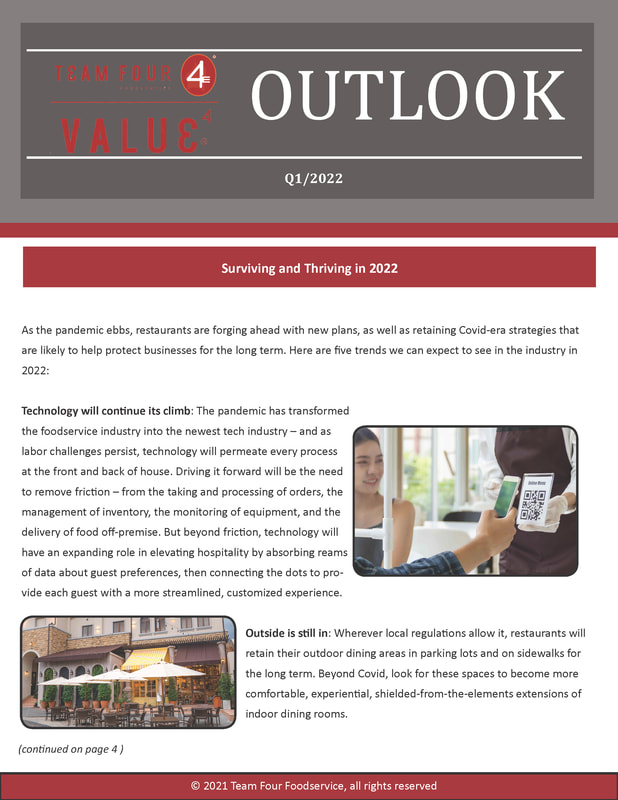 It’s that time of year when people across the food industry are anticipating the trends we will see in 2024. Whole Foods recently shared the predictions of dozens of its team members, to include buyers and culinary experts. At the top of their list are plant-based foods that visibly include vegetables or other natural items. Think short labels and recognizable ingredients as opposed to substances that try to mimic meat. That means we’re likely to see more protein-rich ingredients that add satiety to a dish and which consumers are apt to have in their kitchens – walnuts, mushrooms, legumes and tempeh, for example. Across your menu, are there opportunities to weave in identifiable plant-based ingredients that can add layers, flavor and satisfaction to a vegetarian dish?  If your guest response to plant-based meat replacements on your menu has fallen short of your expectations, you may be part of a trend. A recent Restaurant Dive report mentions that at grocery stores, repeat buyers of plant-based meat are becoming harder to find – and even those who buy it aren’t giving up conventional meat. Meanwhile, restaurants have been trying to figure out the extent of guest demand for these meat analogues. Some brands have dropped them and are instead focusing on offering a great experience with conventional meat, or simply innovating with whole vegetables to offer a less-processed plant-based meal. All of this goes to show that plant-forward consumers remain difficult to define – and it will be important to continue to collect data about how guests respond to your offerings along the protein spectrum.  Although many consumers are still watching their wallets and trading down on restaurant experiences, plant-based foods could be one of restaurant operators’ secret weapons to drive traffic and build loyalty. According to a new report from the Good Food Institute, sales of plant-based proteins (specifically plant-based meat) are rebounding in U.S. foodservice. Further, the people buying these foods make about 30 more trips to restaurants every year and spend about $400 more than the average foodservice guest. That’s a valuable segment to target and transform into loyal visitors. The research found that about 10 percent of U.S. consumers bought plant-based meat alternatives at a foodservice location last year, but the vast majority did so just once, so there is a lot of opportunity for restaurants that present plant-based foods well to capture and expand market share. Restaurants offer the kinds of elevated dining experiences that can make plant-based meat alternatives (along with plants in their natural form) shine. Operators can innovate with seasonal vegetables in ways that are still surprising and craveable to guests and exceed what a person is apt to prepare at home. As you look at the plant-based options on your menu in the months ahead, where is there an opportunity to bring in traffic and improve loyalty?  For many years, vegan consumers were left wanting at restaurants. Unless they were eating at a vegetarian restaurant accustomed to creating dishes that were naturally delicious without the animal products, they generally had to dissect restaurant menu offerings and eat something that had been altered from how the chef intended it. But the tide has turned in recent years, with sales of plant-based foods surging and more consumers actively seeking restaurants that offer fully curated vegan meals – across different restaurant types and across menu categories too. If you’re serving more guests who like plant-based options, are you offering some vegan standouts – or at least some options that are just as tasty with the animal protein removed if requested?  Plant-based foods have been on the rise for some time – and there’s no end in sight. A new report by Bloomberg Intelligence projects the plant-based foods market to comprise a substantial share of the global protein market, reaching 7.7 percent by 2030 – a huge leap from where it was in 2020. Consumer interest in healthy, sustainable foods is driving the trend. Plant-based options are expanding into in new product categories including ice cream, eggs, cheese and seafood options. The recent National Restaurant Association Show reflected the continued rise of plant-based options, with a plant-based tuna filet and shrimp attracting attention and accolades in the seafood category.  Do you serve many vegan or vegetarian guests? Even if your answer is no, your clientele may still crave dairy-free foods. A recent survey of consumers in the U.S. and U.K. found that of those who purchase dairy-free foods, nearly 60 percent did not consider themselves vegan. They may simply want to incorporate more plant-based foods into their flexitarian diets. Offering dairy-free alternatives – and thinking beyond the beverage menu to include your appetizers, entrées and desserts – can help.  Last year, 62 percent of U.S. households (or 79 million) bought plant-based products, up from 61 percent (or 77 million) in 2020, according to the Plant-Based Food Institute. Further, the percentage of consumers purchasing multiple times within the plant-based category grew from 78 percent to 79 percent in the same time frame. The increasing cost of meat, as well as growing consumer awareness of its environmental impacts, were driving the charge toward plant-based alternatives both at home and in restaurants. Now, some nuances are emerging about consumer demand for plant-based meat that may alter the landscape for the restaurant operators serving it. In short, it may not be the draw for flexitarians that it once was. New research from Deloitte found that the appeal of plant-based meat may have reached a saturation point. The research found a decline in the percentage of consumers willing to pay a premium for plant-based meat as opposed to conventional varieties, as well a decline in the attitudes of consumers toward plant-based meat’s sustainability and assumed health benefits. As you consider what to put on the menu, foods that are plant-based (both naturally so and not) are still likely to continue to be a draw. Just anticipate that your guests may scrutinize the plant-based meat on your menu – and may draw a line on costs that’s well below what it would be for the alternative.  In 2021, U.S. retail sales of plant-based foods grew 6.2 percent following a record year of growth in 2020, bringing the total plant-based market value to an all-time high of $7.4 billion, according to data released from the Plant-Based Foods Association, The Good Food Institute and SPINS. Compared to total retail food sales during that time frame, plant-based food retail sales grew three times as fast. Consumers have an appetite for plant-based foods and are continuing to be open to trying plant-based versions of foods traditionally prepared with meat. Consider how you might apply this approach to your menu in even the meatiest of dishes. Where might you reinvent an appetizer or entrée with plant-based ingredients in place of meat, all while keeping the flavor and texture of the dish intact?  You’re no doubt scrutinizing your menu amid ongoing inflation and supply shortages – and animal proteins, which are among the higher-priced foods that consumers and restaurant operators alike are paying for right now, are a key target for reinvention. Consumers are buying less meat at the grocery store due to higher prices and won’t be surprised to see more expensive meat (or fewer beef options) on the menu at the moment. So what’s the best alternative course of action? In addition to pork, which should continue to be a value option, poultry is likely to be a viable choice in the coming months. According to research from BTIG, poultry is due to see substantial deflation in the first quarter of 2023, even as beef prices are poised to continue their climb. In the meantime, while plant-based proteins continue to have an important place at the center of the plate, plant-based beef sales have dipped. (At a time when restaurant meals may be harder to justify, consumers may be more inclined to splurge on the experience of a beef burger over a plant-based one.) Restaurants may benefit by being extra purposeful with the beef-based options on the menu so they feel more experiential. Feature premium cuts as specials. Get creative with less expensive cuts by using them in flavorful marinades featuring on-trend spices. Offer slow-cooked beef to elevate the melt-in-your-mouth experience that helps you make the most of the beef you’re able to buy right now.  As consumers have moved plants to the center of the plate, their embrace of flexitarian options has extended to dairy alternatives. Even if your guests can tolerate dairy in their diets, they may still be curious about dairy alternatives and looking to try them – particularly as the tastes and textures of alternatives dairy products including milk, yogurt, ice cream and cheese have improved in recent years. These more shelf-stable options can help you stretch your inventory as well. Consider non-dairy alternatives in sauces, dips and dressings as a starting point. |
Subscribe to our newsletterArchives
April 2024
Categories
All
|




 RSS Feed
RSS Feed